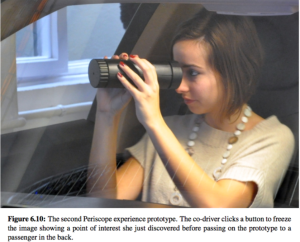Experience prototyping in automobiles
This week’s theme is “Experience Prototyping” [1], a design method that enables designers, clients or users to acquire a deeper understanding of the system experiences of use by using it first hand, or, as the authors describe:
We can say an Experience Prototype is any kind of representation, in any medium, that is designed to understand, explore, or communicate what it might be like to engage with the product, space or system we are designing.
Focusing on experience prototyping, I had chosen “Outside the Brick: Exploring Prototyping for the elderly” [2], which explores and reports on a prototyping DIY kit design to engage senior citizens in the making culture. However, the emphasis is on physical prototyping and making, and not experience prototyping. Instead, and inspired by Kohei Matsumura’s lab talk on HCI in the automotive domain, I selected “The Periscope: An Experience Design Case Study” [2].
This paper provides an in-depth case study of an entire design process (from inception through storyboarding to implementation) of a novel automotive device, including the multiple iterations of experience prototyping of varying resolution and fidelity. The aim of this device is to: “explore the environment and to share discoveries with other passengers in the case” [3]. The second Periscope prototype created and a detailed description of use is illustrated below [4]:
This project was interesting and quite unusual from other HCI literature I have read as the psychological needs of end-users – relatedness and pleasure-stimulation [3] – are explicitly measured to verify the prototypes success, i.e. if the device provides a positive experience. Prototyping experiences are deployed in this case study to understand and evaluate existing and potential user experiences.
I feel that experience prototyping has the potential to be used within communities as a technique to understand participants’ experiences, and their experiences with others. Especially when designing a system to cater for multiple scenarios across civic life. Further, designers could leverage this design method to understand community practices and local experiences of their environments that designers could not understand otherwise.
References:
- Buchenau, M., Fulton, J. Experience Prototyping. Symposium on Designing Interactive Systems, ACM (2000).
- Farina K., Nitsche M. Outside the brick: exploring prototyping for the elderly. In Proc. British HCI, ACM (2015).
- Loehmann, S., Landau, M., Koerber, M., Hausen, D., Proppe, P., and Hackenschmied, M. The Periscope: An Experience Design Case Study. In Proc. AutomotiveUI, ACM (2014).
- Loehmann, S. Experience Prototyping for Automotive Applications. Ph.D thesis, Ludwig Maximilian University of Munich. Available from: [17 April 2015].

Leave a Reply Cancel reply
You must be logged in to post a comment.